Starting a sketchbook is super exciting, and there are tons of ways to make that first page awesome. Some ideas include doodling cute faces or creating a wild burst of color, drawing your favorite stack of books, or turning your tools into cartoon heroes. You can try a funny welcome note in a silly frame, slap on a bold title banner, set sneaky little art goals, or even swatch your supplies for a rainbow grid. Curious? The next ideas get even more creative.
Key Takeaways
- Decorate your welcome page with cute doodles, playful borders, or cartoonish characters to showcase your personal artistic style.
- Create a self-portrait introduction or illustrated “About Me” page using sketches of your favorite art supplies and quirky interests.
- Set the tone with a theme reveal, mood board, or inspirational quote lettered creatively to spark motivation and consistency.
- Organize and test your materials visually by adding a swatch grid of favorite colors and art supplies on the first page.
- List tiny, achievable art goals or a personal mantra to guide your creativity and track progress as you fill your sketchbook.
Cute Doodles and Whimsical Motifs
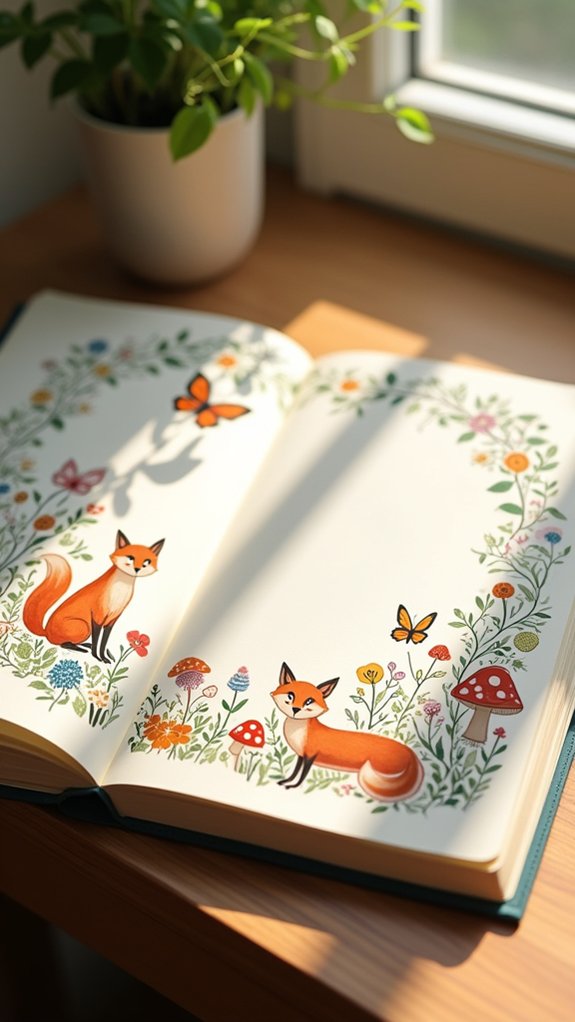
Even before opening to the first sketch, the welcome page is a chance to set the mood—so why not fill it with cute doodles and a dash of whimsy? Little flowers, stars with big grins, or even tiny animals peeking from the corners can turn a blank page into something welcoming and full of possibility.
Whimsical motifs like clouds shaped like bunnies, rainbows that twist, or playful hearts help the artist’s personality shine right from the start. Some people sketch cartoonish characters, while others doodle abstract shapes or fun patterns—there’s no wrong way to do it!
Creating a border using a mix of these cute doodles frames welcome messages in a burst of color. Really, it’s all about making a happy first impression!
Swatch Grid for Favorite Art Supplies
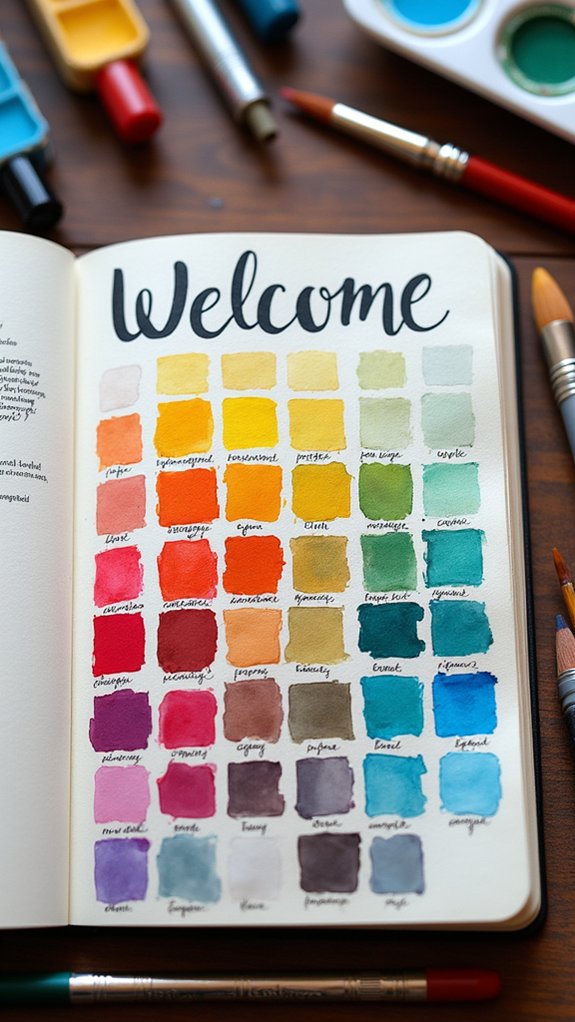
An explosion of color is one of the surest ways to make a sketchbook’s welcome page pop, and that’s where a swatch grid totally shines.
Making a swatch grid for favorite art supplies doesn’t just look cool—it’s actually super useful. Artists can test every marker, watercolor, or colored pencil they love, then label and organize them like a rainbow-fueled science experiment.
Every color gets its own cozy spot, making it way easier to remember which ones really bring your ideas to life. Plus, sometimes a color acts weird on paper—and swatching first means zero ugly surprises later.
Check it out:
- Keeps track of color favorites
- Helps with quick supply choices
- Shows how colors look on paper
- Inspires new creative combos
- Grows with your art journey
Inspiring Quote and Hand-Lettering
Starting your sketchbook with an inspiring quote is like giving your creativity a pep talk every time you open the cover.
Picking a quote that lifts your mood, then hand-lettering it in bold, creative styles adds a spark of personality—plus, it’s great practice if you ever want your notes to look as cool as your doodles.
Mix up your lettering with curly loops, chunky letters, or a splash of color, and you’ve got a welcome page that’s both motivating and totally you.
Choosing Motivational Quotes
So, how does one make the very first page of a sketchbook feel exciting instead of a little scary?
By choosing motivational quotes that lift your spirits and banish that blank-page blues, the welcome page becomes a launchpad instead of a stumbling block.
Hand-lettering these quotes not only helps practice cool typography but also adds a dash of your own style right from the start.
Want to set the vibe? Choose a quote that matches your artistic goals, something that whispers “you got this” every time you open your sketchbook.
Consider these ideas:
- Pick motivational quotes that spark creativity and positivity.
- Go for words that echo your art journey.
- Let your quote remind you it’s okay to make mistakes.
- Hand-letter with playful, bold styles.
- Make it colorful and fun for extra energy!
Creative Hand-Lettering Styles
Every sketchbook artists opens has that powerful first-page moment—one where a single inspiring quote, decked out in creative hand-lettering, can totally transform just plain paper into something epic.
Creative hand-lettering styles like brush script for smooth, flowy vibes, or chunky block letters for a bold look, instantly dial up the wow factor. Want even more flair? Try decorative fonts that play with loops and swirls.
Swapping between brush pens, markers, or calligraphy nibs lets you find the style that feels most “you.” Mixing up colors—think neon bursts or moody shadows—can make your quote pop so much, someone might need sunglasses.
Practicing different creative hand-lettering styles isn’t just fun; it helps shape your unique artistic voice, setting your sketchbook apart from the rest.
Bold Sketchbook Title Banner
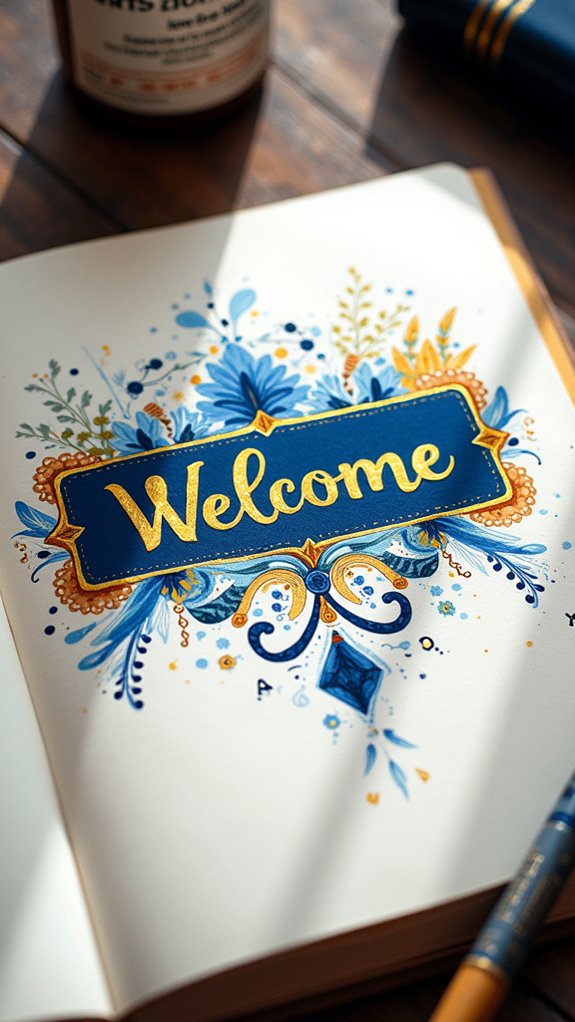
A bold sketchbook title banner is like the grand entrance to an amusement park—it’s the first thing anyone sees, and wow, does it set the mood for everything inside.
When someone opens to that very first page, your bold sketchbook title banner immediately shouts “Welcome!” in a way that’s energetic, eye-catching, and true to you.
Think big fonts, splashy colors, and a sprinkle of your own personality. Framing it with doodles, quirky borders, or even a monster with a welcome sign can turn your page into a creative red carpet.
- Super-sized, unique fonts grab attention
- Bright colors reflect your style and mood
- Fun illustrations or doodles add context
- Decorative borders bring everything together
- Playing with different lettering shows off your skills
Let your banner be your artistic handshake!
Minimalist Pattern Play
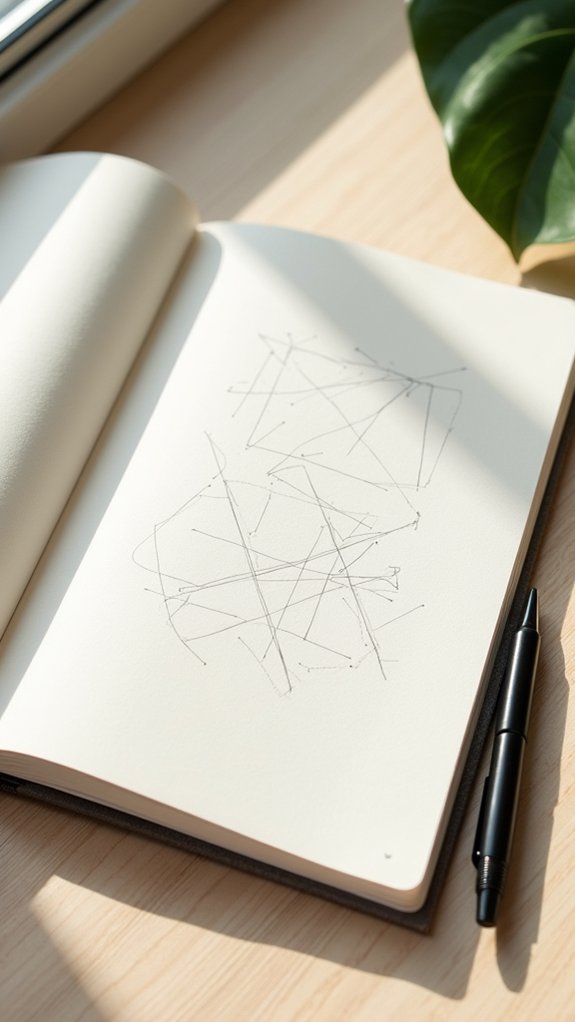
Even though bold banners can steal the show, sometimes less really is more, and that’s where minimalist pattern play comes in.
Imagine a welcome page where simple lines and shapes come together, creating a look that’s interesting without screaming for attention. Minimalist pattern play is all about filling the space with geometric designs, like dots, stripes, or triangles, but leaving enough negative space so everything looks chill—not overwhelming.
Limiting your color palette makes the patterns stand out, almost like they’re whispering, “Welcome!” Repetition makes the page feel inviting and rhythmic, while experimenting with thick or thin lines adds just the right touch of depth.
It’s perfect if you want a sketchbook that’s calm on the eyes but still totally stylish and original.
Colorful Abstract Backgrounds
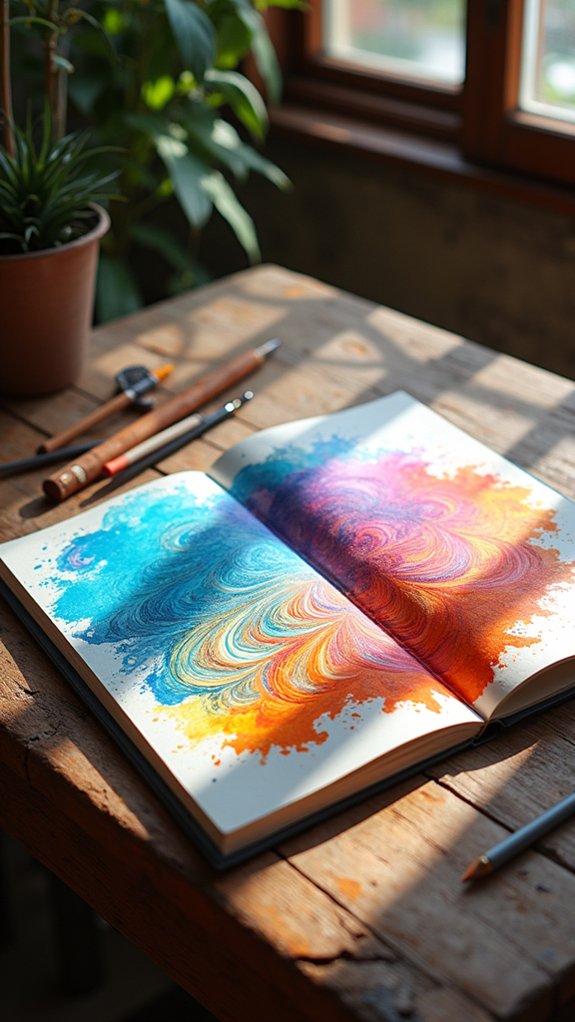
When splashes of color burst across the page, it’s hard not to get thrilled about what’s coming next. Colorful abstract backgrounds turn an ordinary sketchbook welcome page into an open invitation to creativity.
There’s no need to worry about making it perfect—abstract means letting colors and shapes flow freely, so mistakes just add character. Even if a blob looks more like a puddle, that’s all part of the fun!
Artists can experiment with watercolors, markers, or acrylics to craft something totally unique. A bold mixture of patterns and colors can make anyone enthusiastic to put pencil to paper.
- Inviting backgrounds break the blank page fear
- Abstract styles spark creativity without pressure
- Different media encourage playful experimentation
- Warm and cool colors create an emotional vibe
- The page stays flexible for sketches or words
Self-Portrait Greets the Viewer
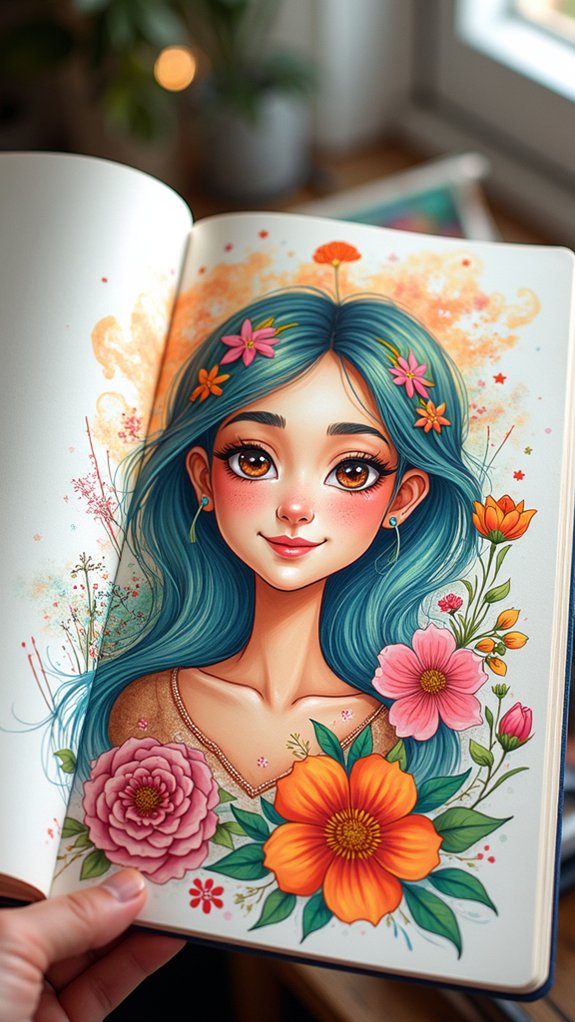
Kicking off your sketchbook with a self-portrait is like saying, “Hey, this is me—welcome to my world!”
It’s a fun way to show off your personality and let your artistic style shine, whether you’re quirky, serious, or somewhere in between.
Plus, a friendly smile or funny pose on the first page instantly sets the mood, making the whole sketchbook feel more inviting and personal.
Expressing Personality Visually
Opening a sketchbook and being greeted by a self-portrait is like meeting the artist at the door, ready to say, “Hey, come on in!”
It’s more than just a drawing of a face—it’s a way to show off who the artist really is, quirks and all. Each self-portrait says something unique, depending on the colors, styles, and even goofy details the artist adds.
Some show off favorite hats, wild hair, or a pet cat perched on a shoulder. The welcome page is where personality bursts out first, showing visitors what kind of creative world they’re about to explore.
- Highlights favorite colors and artistic styles
- Incorporates symbols or accessories reflecting interests
- Includes fun facts or short stories next to the portrait
- Experiments with mixed media or unusual techniques
- Shows off mood, humor, or signature quirks
Setting a Friendly Tone
How does it feel to flip to the first page of a sketchbook and be greeted by a self-portrait that almost waves hello? Instantly, the mood shifts—it’s like meeting a friendly host at the door instead of stepping into a cold, empty room.
A self-portrait on the welcome page isn’t just about drawing a face; it’s about sharing a moment of joy or a spark of creativity right from the start. Using playful features, a quirky hat, or a huge cheesy grin pulls viewers in with a wink and a smile.
Add a short caption like “Let’s draw together!” or jot a silly greeting and the friendliness dials up even more. A bright color palette? That’s like sunshine in marker form.
Showcasing Artistic Style
A self-portrait on the welcome page isn’t just a regular drawing—it’s a personal handshake, art-style. Right from the start, it gives viewers a peek at who the artist really is, setting the whole vibe for the sketchbook.
And this isn’t about creating a stiff, formal picture either. There’s tons of room for creativity! A self-portrait can be packed with color, bold lines, and hints about the artist’s favorite things. Quirky details, hobbies, or even a funny doodle in the corner can show personality loud and clear.
- Highlights an artist’s unique style through choice of colors and textures
- Offers a mini-bio with clues about interests or favorite themes
- Welcomes viewers in with a warm, inviting touch
- Sparks curiosity about what’s inside
- Makes the sketchbook approachable and fun
About Me: Illustrated Snapshot
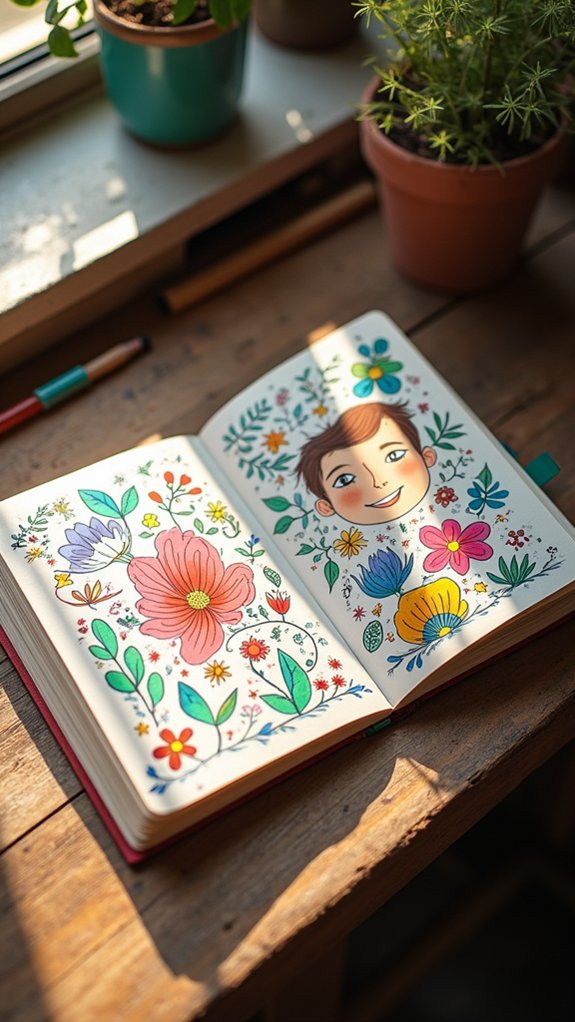
Even before someone flips past the welcome page, an “About Me: Illustrated Snapshot” jumps right in to introduce the artist behind the sketchbook.
This sketchbook page doesn’t just drop a name and age; it sparkles with doodles of everything the artist loves. Readers can spot quick sketches of favorite art supplies—maybe a grumpy looking marker or a paintbrush with a secret smile.
Next to the self-portrait, there’s a list: dream subjects, preferred styles, maybe even a goofy fact (like, “Can’t draw without a playlist blaring!”).
Hobbies tumble across the page—soccer balls, stacks of books, or a slice of pizza—giving hints about what inspires the art. The mix of text and illustration keeps this intro fun, honest, and totally one-of-a-kind.
Fandom Flashback Collage

While flipping open a new sketchbook, nothing explodes with energy quite like a Fandom Flashback Collage front and center. It’s like your sketchbook is shouting, “Welcome, fellow fan!”
Right away, it’s a wall-to-wall tribute to everything you’ve loved over the years—think favorite characters, legendary quotes, and unforgettable symbols. Whether you’re cutting up magazines, printing, or drawing doodles from memory, the collage jumps with color and style.
For that extra personal zing, adding signatures from fan events or tiny snapshots of epic moments makes the collage pop and gives it history.
Let’s break down why a fandom flashback collage totally rocks:
- Nostalgic character mashups
- Quotes that make you smile
- Dynamic, energetic textures
- Event mementos and autographs
- Captions explaining emotional connections
Theme Reveal and Mood Board

After soaking in the wild energy of a fandom flashback collage, there’s a whole different kind of thrill in flipping to a welcome page that lays out your sketchbook’s theme with a bang.
This is where the mighty theme reveal happens—a dramatic intro to what your sketchbook stands for! Think: bold titles, maybe a catchy quote, even a doodle or two that totally scream your vibe.
But don’t stop there. Bring on the mood board! Grab scraps of color, bits of magazine, and any stickers or swatches that match your theme.
Organize them in sections—color palettes, style ideas, and what you want to draw. Referencing your mood board keeps you pumped up and guarantees every new page fits your awesome theme from start to finish.
Flora and Fauna Welcome Spread
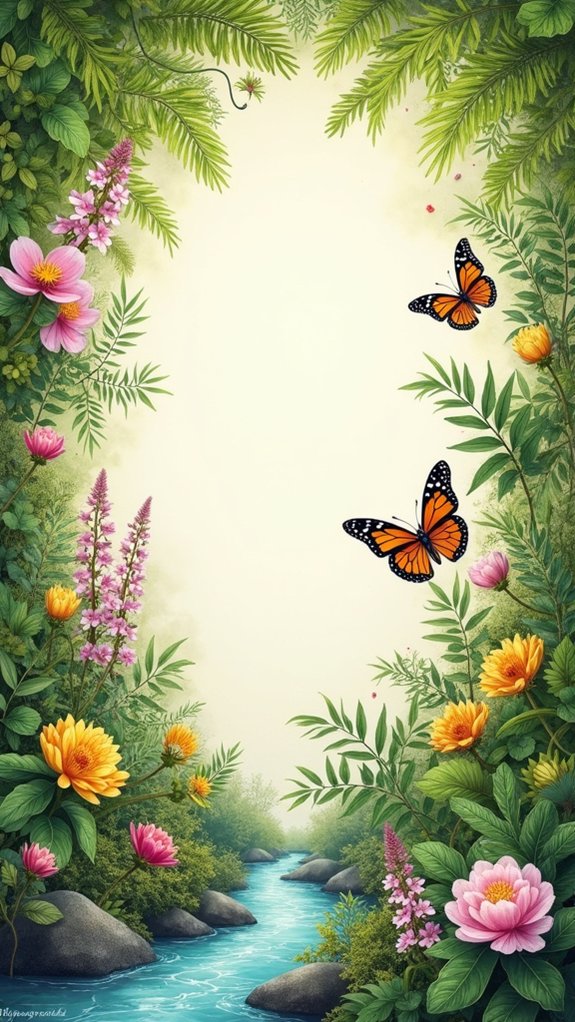
A Flora and Fauna Welcome Spread is all about bringing the wild side of nature right onto your sketchbook’s first pages—think twisting vines, blooming flowers, and some cheeky little animals showing off.
Botanical motifs can spark so many creative ideas, while sketches of animals like birds or butterflies instantly make the page feel cozy and fun, almost like you’re inviting a forest to say hello.
With these elements, each time you open your sketchbook, it’s like stepping into your own friendly jungle, and who wouldn’t want a squirrel or a sunflower cheering them on?
Botanical Motifs for Inspiration
Botanical motifs open the door to a sketchbook welcome page that feels bursting with life. It’s like inviting a lush garden to greet anyone who flips that first page!
Drawing things like curling vines, bold leaves, or cheerful flowers sets a calm, creative vibe—and hey, it’s a little like letting nature cheer you on as you start fresh. Toss in pops of color with watercolors or colored pencils, and that spread instantly feels more vibrant, like it’s blooming just for you.
For even more depth and a dash of personality, sneak in the plants’ scientific names or jot down why a specific bloom matters to you.
- Frame the page with leafy borders
- Layer flower types for texture
- Use splashes of green for freshness
- Mix soft pastels for gentleness
- Add scientific names for intrigue
Animal Illustrations for Warmth
When someone flips open a sketchbook and spots a friendly fox, a curious bunny, or a wise old owl peeking out from the first page, it instantly feels like they’ve stepped into a story.
Animal illustrations add instant warmth, making that fresh, blank page feel a little less intimidating and way more inviting. Sketching animals you connect with—like a brave lion or quirky owl—can even remind you of the qualities you want to embrace.
Throw in some bright colors, funky fur patterns, or silly expressions, and suddenly your welcome page has real personality. Pair those animal illustrations with doodles of leafy plants or wildflowers, and you’ve got a cozy, nature-inspired vibe.
It’s like a creative pep talk every time you open your sketchbook!
Zentangle and Meditative Lines
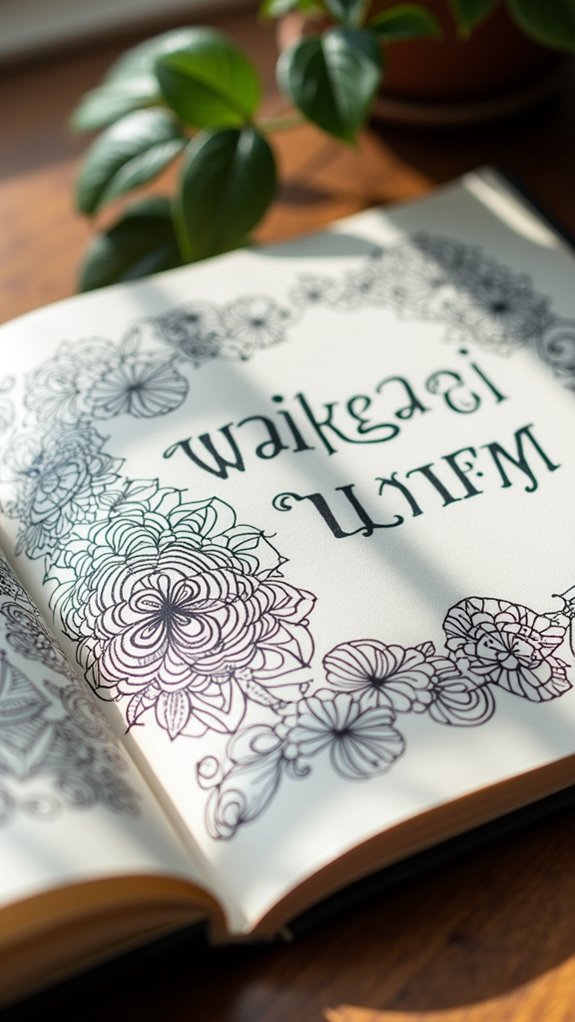
Plenty of artists know the blank first page of a new sketchbook can feel like it’s staring right back at them, almost daring them to mess up.
Zentangle offers the ideal no-pressure response to that intimidating emptiness. Instead of worrying about making something perfect, artists can plunge into meditative lines and patterns, letting their pens wander.
Zentangle is about drawing structured, repetitive shapes, which isn’t just relaxing—it helps kickstart creativity, too. No one expects a masterpiece; it’s all about the joyful process.
For those ready to try, here’s what Zentangle on the welcome page can bring:
- Reduces anxiety with calming, rhythmic marks
- Encourages artistic freedom and surprise
- Welcomes mistakes as part of the art
- Sharpens drawing skills through practice
- Turns the first page into a creative adventure
Date Started and Tiny Goals List
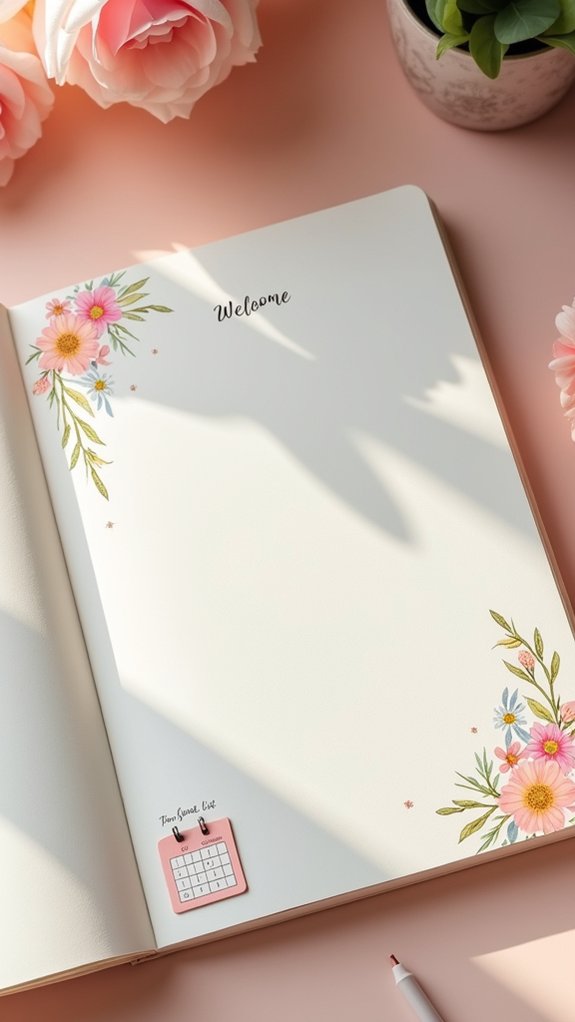
Marking the date you start your sketchbook isn’t just a fun ritual—it instantly creates a sense of occasion, almost like releasing a brand new game.
Adding a tiny goals list right on the welcome page gives each drawing session some direction, whether you’re chasing a streak or just trying not to lose your favorite pen in the couch cushions (again).
Marking Your Sketchbook Start
A fresh start feels electric—kind of like opening a brand new game and smelling that “new book” smell all at once.
Marking your sketchbook start on the sketchbook welcome page isn’t just about scribbling down a date—it’s about showing you’re ready to commence on a creative adventure.
Creating a tiny goals list right on that first page launches your sketchbook with purpose and keeps you coming back when inspiration tries to take a nap.
- Jot down the date you started as your personal “level 1.”
- List small, doable art goals to spark motivation.
- Check off goals as you smash them—each tick feels awesome!
- Snap back to your list when you feel stuck; it’s your roadmap.
- Regularly glance at your welcome page to stay fired up.
Setting Achievable Art Goals
Most creative journeys kick off with a spark, and setting clear art goals on your sketchbook’s welcome page can feel like hitting the “start” button on a personal quest.
Picking an official date to begin (even if it’s just today or—let’s be real—five minutes ago) makes things feel serious but still fun.
A tiny goals list, like “finish one drawing a week” or “test a new medium every month,” brings big dreams down to earth, bite by bite.
Breaking bigger art plans into smaller steps means more mini-high-fives and less staring in panic at a blank sketch book page.
Each checkmark you make is a reason to celebrate, boosting your confidence and turning every little victory into fuel for the next creation.
Tracking Progress With Dates
Nothing beats the excitement of starting a brand-new sketchbook—blank pages waiting, pens ready, and ideas buzzing like bees at a picnic.
One fun way to keep that energy going is by tracking progress with dates right on the welcome page. Marking down the date you start is like planting a flag at the beginning of your artistic journey.
Next, jotting down a tiny goals list can help break things into bite-sized steps—much less scary than one huge goal, right?
Here’s why those two habits can be a game changer:
- Reveals how your art style changes over time
- Builds motivation by checking off finished goals
- Helps you stick to drawing regularly
- Lets you see how fast (or slow!) you’re progressing
- Sparks creative ideas when you reflect on your journey
Personal Mantra or Mission Statement
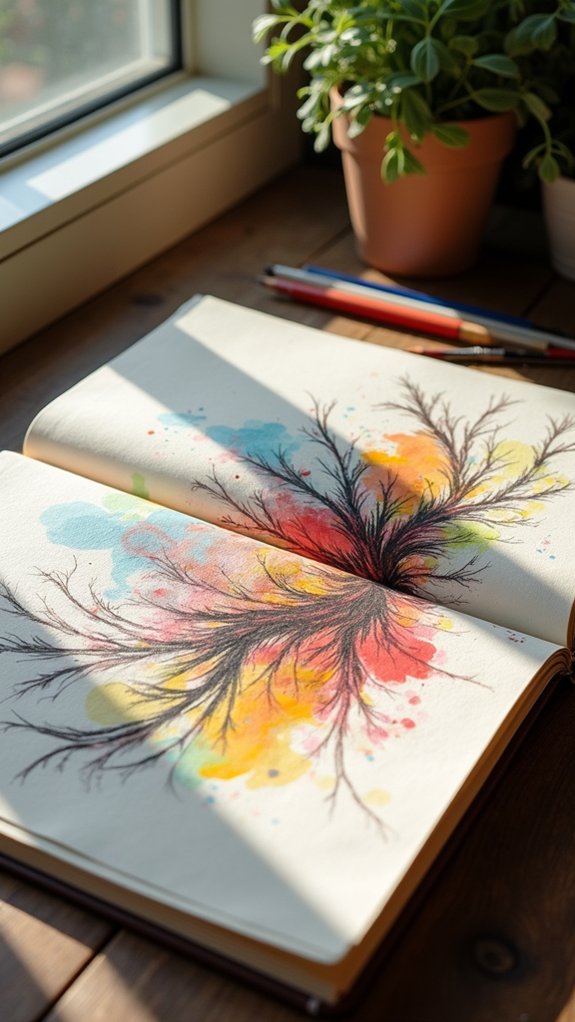
Inspiration can be a powerful tool, especially when starting a new sketchbook. One fun way to boost motivation is by jotting down a personal mantra or a simple mission statement right on the welcome page.
A personal mantra is like a secret code that keeps artists focused, and it can be anything from “Mistakes make magic” to “Draw every day, no excuses!” Not only does this tiny sentence remind artists to be kind to themselves, but it also helps them push through creative blocks.
A mission statement sets the stage for every doodle, squiggle, and splash of color that follows. Plus, as artists grow and change, reworking their mantra can keep things fresh—sort of like leveling up in a video game!
Stack of Books or Art Tools Drawing
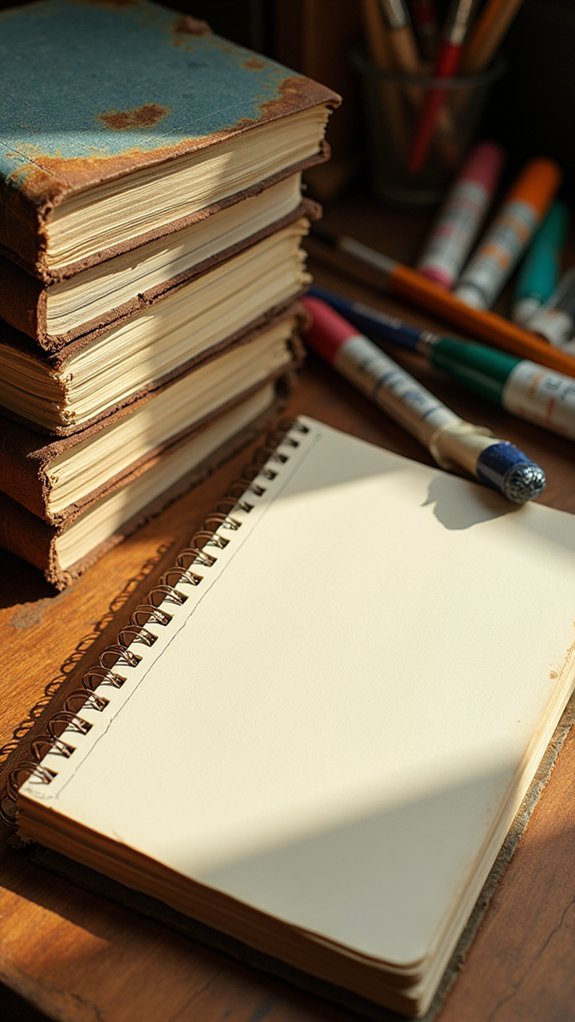
A sketchbook welcome page with a stack of books and scattered art tools really packs a punch—it instantly shows off the creative essentials that are about to shape every page.
Just imagine brushes, pencils, and colorful markers piling up next to a leaning tower of sketchbooks, practically buzzing with inspiration (plus, they’re less wobbly than actual Jenga).
This setup isn’t just neat to look at; it also lets artists spotlight what inspires them most, almost like inviting someone to peek inside their creative backpack.
Illustrating Creative Essentials Stack
When someone opens the cover of a new sketchbook, there’s an electric kind of excitement—like standing at the gate of an awesome theme park with a ticket in hand.
That very first page is a blank canvas, begging for something cool. Illustrating a creative essentials stack—think a pile of sketchbooks or a jumble of art tools—turns that page into a map of your artistic journey. It shows what inspires you, what you love to use, and sets the tone for the whole sketchbook.
Want to make it more personal and fun? Try these tricks:
- Add doodles of your favorite tools (goofy or realistic, your call).
- Sneak in your top art book titles on spines.
- Blend textures for depth.
- Play with bright, bold colors.
- Leave space to add new favorites!
Showcasing Artistic Inspirations
How does someone even begin to fill that very first page in a fresh sketchbook? One cool idea is to draw a stack of books that represent all the knowledge and inspiration collected over time.
Imagine sketching titles from your favorite artists—or maybe tossing in art tools like brushes, pencils, and palettes. It’s like making a mini museum of your creative journey right on the welcome page!
Bright colors can turn even simple sketches into a burst of personality, and adding different styles or fun doodles keeps things true to you.
Want more motivation? Write inspiring quotes about art around your drawings. It’s a page that cheers you on whenever you open your sketchbook, making that blank space feel welcoming instead of scary.
Welcome Note in Decorative Frames
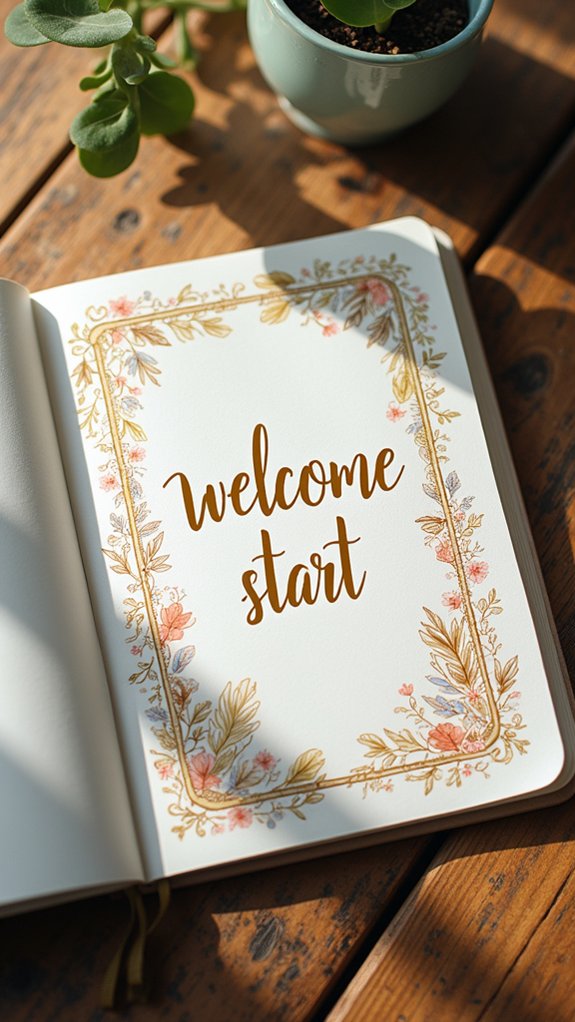
Even before any sketches fill the page, there’s something so exciting about a welcome note framed in a burst of creativity.
On a welcome page, a decorative frame makes the message pop, as though it’s standing at the door waving hello. Instead of just scribbling “Welcome!” across the top, artists take it a step further—surrounding the note with frames that match their vibe.
It’s an open invitation for imagination to run wild. For anyone looking to add some ✨wow✨ to their welcome page, try experimenting with:
- Floral or leafy borders for a nature-inspired feel.
- Geometric shapes or patterns to show off modern style.
- Whimsical doodles that make the page playful.
- Hand-lettered phrases with quirky fonts.
- Bold colors that speak your artistic language.
Signature Style Sampler Page
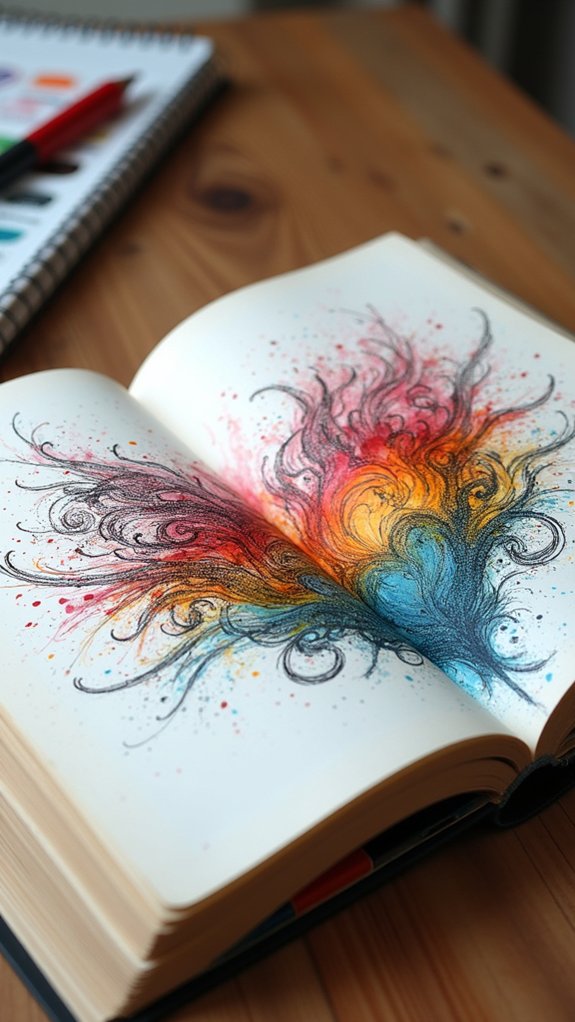
Frames and fancy borders make a welcome page shine, but there’s another way to let someone peek at an artist’s true self from the very start. That’s where the signature style sampler page comes in, like your own VIP section for art experiments.
This page is kind of like a greatest-hits playlist—for your favorite drawing styles, cool doodle habits, and the art tools you always grab first. Artists splatter bits of watercolor here, test out a speedy ink sketch there, maybe scribble notes about what brush makes the juiciest lines.
Mix up textures, toss on color swatches, and label the best bits for later. Every time you flip back, you’ll spot what makes your sketchbook totally you. Plus, it’s just fun.
Blank Space With Invitation to Begin

Kick off a sketchbook adventure with something bold but totally simple—a blank page that practically begs for the first mark.
Using a blank space on the welcome page is like rolling out a giant “Welcome” mat for creativity. Instead of cramming it with doodles or notes, the emptiness is pretty much an open door. It wipes away the scary idea of mistakes and just lets anyone get started—even if it’s with a wobbly circle or a wild squiggle.
Maybe add a light border, or scribble “Welcome to My Creative Space” in the corner for fun vibes.
- Blank space sets a chill, no-pressure mood
- Encourages freedom to try anything
- Lowers the fear of messing up
- Invites personal touches anytime
- Kicks off the sketchbook journey wide open
Frequently Asked Questions
What Should I Put on the First Page of My Sketchbook?
The question of what belongs on the first page of a sketchbook invites exploration of Creative Inspiration. Artists may include their name, date, a motivational quote, a themed title, or an imaginative doodle to spark creative momentum.
How Do You Start Your First Sketchbook?
When contemplating Creative Beginnings in a first sketchbook, one might focus on experimentation, using the initial pages for swatches, themes, or familiar sketches. This approach nurtures confidence, eases pressure, and encourages artistic growth through embracing imperfection.
What Should I Draw on My First Page?
When considering what to draw on a first page, individuals may explore creative prompts such as personal doodles, inspiring quotes, color swatches, or relaxing Zentangle patterns, allowing for a personalized and encouraging introduction to their artistic journey.
How Do You Make a New Page on Sketchbook?
To create a new page in a sketchbook, an artist simply turns to the next blank sheet. Gentle handling preserves the binding, and planning the page layout with preliminary sketches helps organize ideas before adding more permanent details.
Conclusion
Starting a sketchbook can feel scary, like staring at a monster under the bed. But with these 18 welcome page ideas, even the blankest page gets a glow-up. Whether it’s wild doodles, favorite color swatches, or a punchy quote, anyone can set the vibe. Every artist deserves a fresh start. So jump in, scribble boldly, and let your creativity outshine any scary emptiness. The first page isn’t perfect—it’s just yours. Go make some art magic!

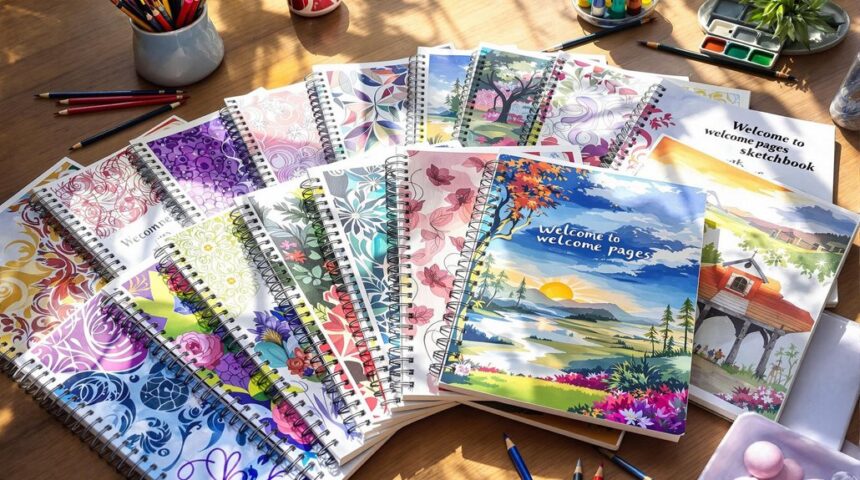
Leave a Reply